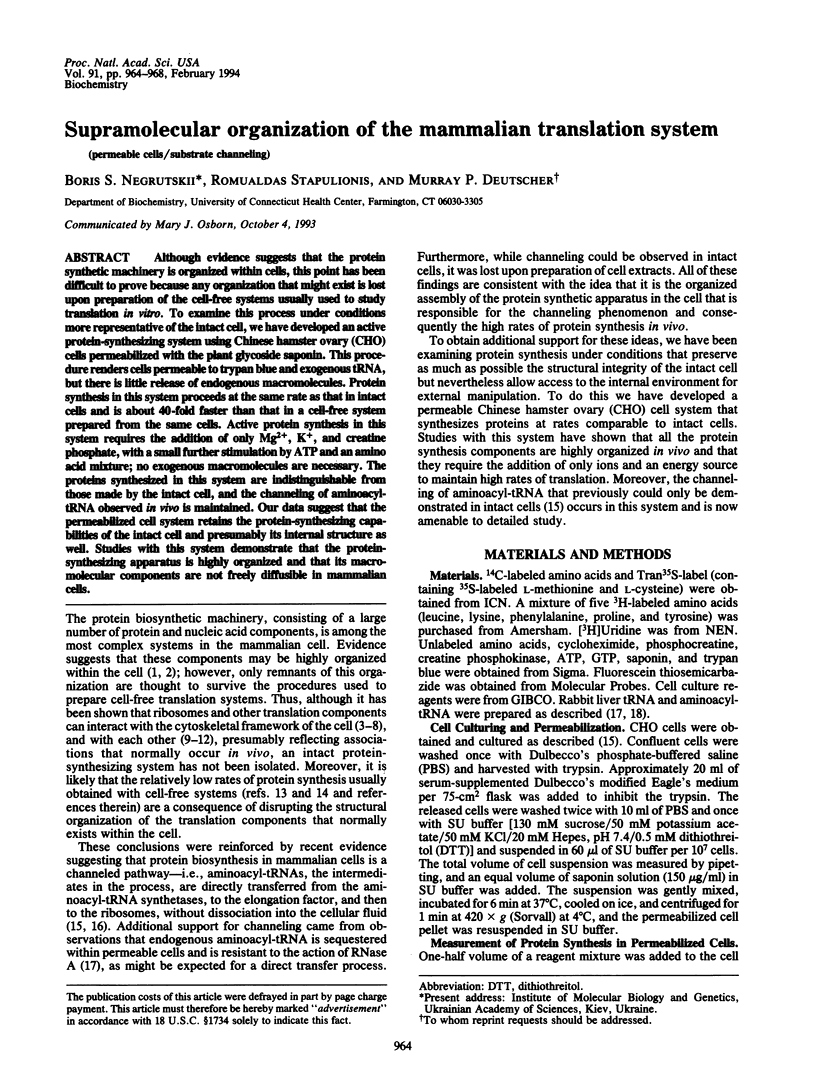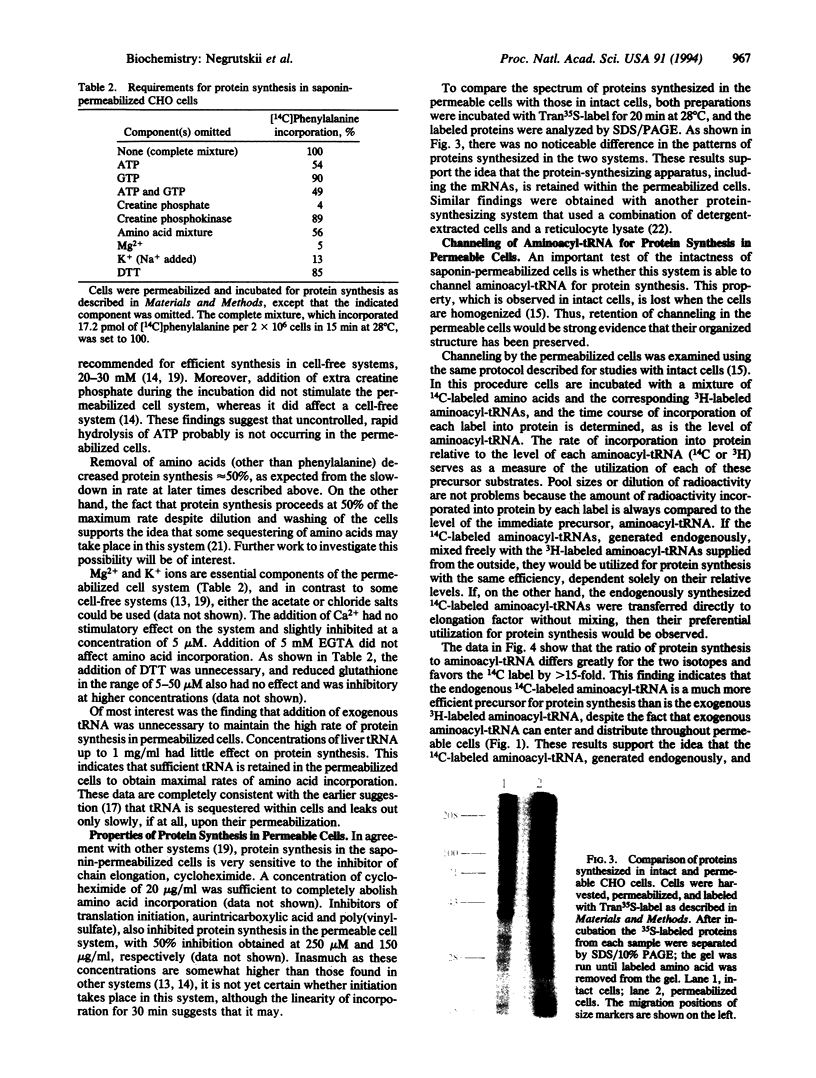Abstract
Although evidence suggests that the protein synthetic machinery is organized within cells, this point has been difficult to prove because any organization that might exist is lost upon preparation of the cell-free systems usually used to study translation in vitro. To examine this process under conditions more representative of the intact cell, we have developed an active protein-synthesizing system using Chinese hamster ovary (CHO) cells permeabilized with the plant glycoside saponin. This procedure renders cells permeable to trypan blue and exogenous tRNA, but there is little release of endogenous macromolecules. Protein synthesis in this system proceeds at the same rate as that in intact cells and is about 40-fold faster than that in a cell-free system prepared from the same cells. Active protein synthesis in this system requires the addition of only Mg2+, K+, and creatine phosphate, with a small further stimulation by ATP and an amino acid mixture; no exogenous macromolecules are necessary. The proteins synthesized in this system are indistinguishable from those made by the intact cell, and the channeling of aminoacyl-tRNA observed in vivo is maintained. Our data suggest that the permeabilized cell system retains the protein-synthesizing capabilities of the intact cell and presumably its internal structure as well. Studies with this system demonstrate that the protein-synthesizing apparatus is highly organized and that its macromolecular components are not freely diffusible in mammalian cells.
Full text
PDF




Images in this article
Selected References
These references are in PubMed. This may not be the complete list of references from this article.
- Bec G., Kerjan P., Zha X. D., Waller J. P. Valyl-tRNA synthetase from rabbit liver. I. Purification as a heterotypic complex in association with elongation factor 1. J Biol Chem. 1989 Dec 15;264(35):21131–21137. [PubMed] [Google Scholar]
- Biegel D., Pachter J. S. "In situ" translation: use of the cytoskeletal framework to direct cell-free protein synthesis. In Vitro Cell Dev Biol. 1991 Jan;27(1):75–85. doi: 10.1007/BF02630897. [DOI] [PubMed] [Google Scholar]
- Dang C. V., Yang D. C., Pollard T. D. Association of methionyl-tRNA synthetase with detergent-insoluble components of the rough endoplasmic reticulum. J Cell Biol. 1983 Apr;96(4):1138–1147. doi: 10.1083/jcb.96.4.1138. [DOI] [PMC free article] [PubMed] [Google Scholar]
- Deutscher M. P. Reactions at the 3' terminus of transfer ribonucleic acid. 3. Catalytic properties of two purified rabbit liver transfer ribonucleic acid nucleotidyl transferases. J Biol Chem. 1972 Jan 25;247(2):459–468. [PubMed] [Google Scholar]
- Deutscher M. P. The eucaryotic aminoacyl-tRNA synthetase complex: suggestions for its structure and function. J Cell Biol. 1984 Aug;99(2):373–377. doi: 10.1083/jcb.99.2.373. [DOI] [PMC free article] [PubMed] [Google Scholar]
- Dreyfuss G., Adam S. A., Choi Y. D. Physical change in cytoplasmic messenger ribonucleoproteins in cells treated with inhibitors of mRNA transcription. Mol Cell Biol. 1984 Mar;4(3):415–423. doi: 10.1128/mcb.4.3.415. [DOI] [PMC free article] [PubMed] [Google Scholar]
- Eisenstein R. S., Harper A. E. Characterization of a protein synthesis system from rat liver. Translation of endogenous and exogenous messenger RNA. J Biol Chem. 1984 Aug 10;259(15):9922–9928. [PubMed] [Google Scholar]
- Graf H. Intraction of aminoacyl-tRNA synthetases with ribosomes and ribosomal subunits. Biochim Biophys Acta. 1976 Mar 4;425(2):175–184. doi: 10.1016/0005-2787(76)90023-x. [DOI] [PubMed] [Google Scholar]
- Howe J. G., Hershey J. W. Translational initiation factor and ribosome association with the cytoskeletal framework fraction from HeLa cells. Cell. 1984 May;37(1):85–93. doi: 10.1016/0092-8674(84)90303-9. [DOI] [PubMed] [Google Scholar]
- Irvin J. D., Hardesty B. Binding of aminoacyl transfer ribonucleic acid synthetases to ribosomes from rabbit reticulocytes. Biochemistry. 1972 May 9;11(10):1915–1920. doi: 10.1021/bi00760a028. [DOI] [PubMed] [Google Scholar]
- Kimball S. R., Everson W. V., Flaim K. E., Jefferson L. S. Initiation of protein synthesis in a cell-free system prepared from rat hepatocytes. Am J Physiol. 1989 Jan;256(1 Pt 1):C28–C34. doi: 10.1152/ajpcell.1989.256.1.C28. [DOI] [PubMed] [Google Scholar]
- Lenk R., Ransom L., Kaufmann Y., Penman S. A cytoskeletal structure with associated polyribosomes obtained from HeLa cells. Cell. 1977 Jan;10(1):67–78. doi: 10.1016/0092-8674(77)90141-6. [DOI] [PubMed] [Google Scholar]
- Lin A., Krockmalnic G., Penman S. Imaging cytoskeleton--mitochondrial membrane attachments by embedment-free electron microscopy of saponin-extracted cells. Proc Natl Acad Sci U S A. 1990 Nov;87(21):8565–8569. doi: 10.1073/pnas.87.21.8565. [DOI] [PMC free article] [PubMed] [Google Scholar]
- Miseta A., Woodley C. L., Greenberg J. R., Slobin L. I. Mammalian seryl-tRNA synthetase associates with mRNA in vivo and has homology to elongation factor 1 alpha. J Biol Chem. 1991 Oct 15;266(29):19158–19161. [PubMed] [Google Scholar]
- Morley S. J., Jackson R. J. Preparation and properties of an improved cell-free protein synthesis system from mammalian liver. Biochim Biophys Acta. 1985 May 24;825(1):45–56. doi: 10.1016/0167-4781(85)90078-8. [DOI] [PubMed] [Google Scholar]
- Negrutskii B. S., Deutscher M. P. A sequestered pool of aminoacyl-tRNA in mammalian cells. Proc Natl Acad Sci U S A. 1992 Apr 15;89(8):3601–3604. doi: 10.1073/pnas.89.8.3601. [DOI] [PMC free article] [PubMed] [Google Scholar]
- Negrutskii B. S., Deutscher M. P. Channeling of aminoacyl-tRNA for protein synthesis in vivo. Proc Natl Acad Sci U S A. 1991 Jun 1;88(11):4991–4995. doi: 10.1073/pnas.88.11.4991. [DOI] [PMC free article] [PubMed] [Google Scholar]
- Pachter J. S. Association of mRNA with the cytoskeletal framework: its role in the regulation of gene expression. Crit Rev Eukaryot Gene Expr. 1992;2(1):1–18. [PubMed] [Google Scholar]
- Ryazanov A. G., Ovchinnikov L. P., Spirin A. S. Development of structural organization of protein-synthesizing machinery from prokaryotes to eukaryotes. Biosystems. 1987;20(3):275–288. doi: 10.1016/0303-2647(87)90035-9. [DOI] [PubMed] [Google Scholar]
- Singer R. H. The cytoskeleton and mRNA localization. Curr Opin Cell Biol. 1992 Feb;4(1):15–19. doi: 10.1016/0955-0674(92)90053-f. [DOI] [PubMed] [Google Scholar]
- Sivaram P., Deutscher M. P. Existence of two forms of rat liver arginyl-tRNA synthetase suggests channeling of aminoacyl-tRNA for protein synthesis. Proc Natl Acad Sci U S A. 1990 May;87(10):3665–3669. doi: 10.1073/pnas.87.10.3665. [DOI] [PMC free article] [PubMed] [Google Scholar]
- Srere P. A. Complexes of sequential metabolic enzymes. Annu Rev Biochem. 1987;56:89–124. doi: 10.1146/annurev.bi.56.070187.000513. [DOI] [PubMed] [Google Scholar]
- Vidrich A., Airhart J., Bruno M. K., Khairallah E. A. Compartmentation of free amino acids for protein biosynthesis. Influence of diurnal changes in hepatic amino acid concentrations of the composition of the precursor pool charging aminoacyl-transfer ribonucleic acid. Biochem J. 1977 Feb 15;162(2):257–266. doi: 10.1042/bj1620257. [DOI] [PMC free article] [PubMed] [Google Scholar]
- Voelker D. R. Characterization of phosphatidylserine synthesis and translocation in permeabilized animal cells. J Biol Chem. 1990 Aug 25;265(24):14340–14346. [PubMed] [Google Scholar]
- Yang F., Demma M., Warren V., Dharmawardhane S., Condeelis J. Identification of an actin-binding protein from Dictyostelium as elongation factor 1a. Nature. 1990 Oct 4;347(6292):494–496. doi: 10.1038/347494a0. [DOI] [PubMed] [Google Scholar]




